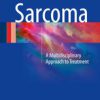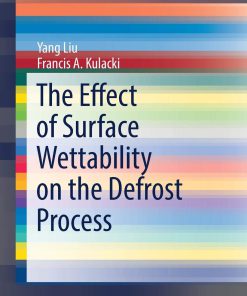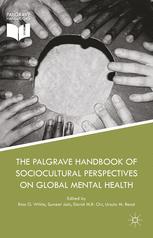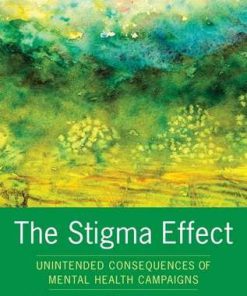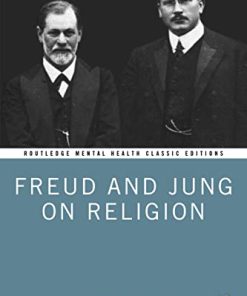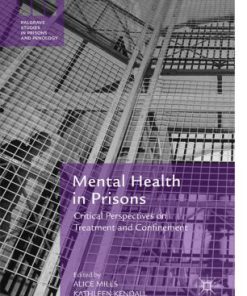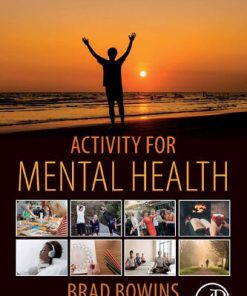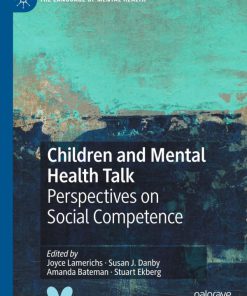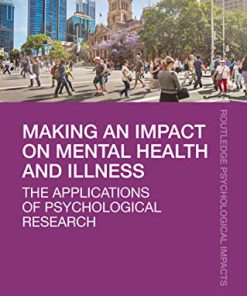The Exercise Effect on Mental Health Neurobiological Mechanisms 1st Edition by Henning Budde 1498739528 9781498739528
$50.00 Original price was: $50.00.$25.00Current price is: $25.00.
The Exercise Effect on Mental Health: Neurobiological Mechanisms 1st Edition by Henning Budde – Ebook PDF Instant Download/DeliveryISBN: 1498739528, 9781498739528
Full download The Exercise Effect on Mental Health: Neurobiological Mechanisms 1st Edition after payment.
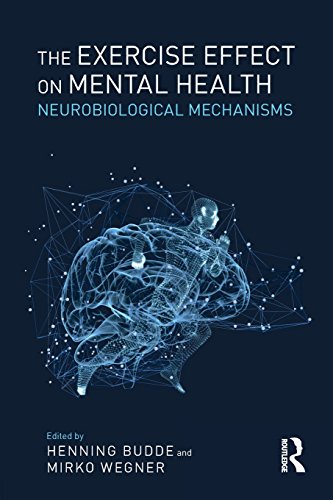
Product details:
ISBN-10 : 1498739528
ISBN-13 : 9781498739528
Author: Henning Budde
The Exercise Effect on Mental Health contains the most recent and thorough overview of the links between exercise and mental health, and the underlying mechanisms of the brain. The text will enhance interested clinicians’ and researchers’ understanding of the neurobiological effect of exercise on mental health. Editors Budde and Wegner have compiled a comprehensive review of the ways in which physical activity impacts the neurobiological mechanisms of the most common psychological and psychiatric disorders, including depression, anxiety, bipolar disorder, and schizophrenia. This text presents a rigorously evidence-based case for exercise as an inexpensive, time-saving, and highly effective treatment for those suffering from mental illness and distress.
The Exercise Effect on Mental Health: Neurobiological Mechanisms 1st Table of contents:
Section 1 The Benefits of Exercise – a Theoretical Introduction (Mechanisms)
1 Epidemiology of Common Mental Disorders
Prevalence and Incidence
Sociodemographic Risk Factors
Gender
Age
Marital Status
Social Economic Status
Life Events
Stigma and Discrimination
Comorbidity
Psychiatric Comorbidity
Physical Comorbidity
Physical Activity
Course of Major Depression
Child and Adolescent Studies
Societal Cost
Global Burden of Disease
Treatment Gap
Conclusion
References
2 Neurobiological Changes as an Explanation of Benefits of Exercise
Introduction
Neurochemical Hypotheses for Depression and Anxiety
Catecholamines Hypothesis
Monoamine Hypothesis
Hypothalamic-Pituitary-Adrenal Axis Hormones, and Depression and Anxiety
Brain-Derived Neurotrophic Factor Hypothesis and Morphological Considerations
Physiological Changes Caused by Acute and Chronic Exercise
Neurochemicals, Exercise and Depression, Anxiety and Well-Being
Catecholamines
Synthesis and Release
Catecholamines During Exercise
Evidence for Acute Exercise-Induced Increases in Brain Concentrations of Catecholamines
Long-Term Effects of Exercise-Induced Changes in Brain Catecholamines Concentrations
5-Hydroxytryptamine
Synthesis and Release
5-Hydroxytryptamine and Exercise
Hypothalamic-Pituitary-Adrenal Axis Hormones
Synthesis and Release
Evidence for Acute Exercise-Induced Increases in Brain Concentrations of HPA Axis Hormones
Long-Term Effects of Exercise-Induced Changes in Brain HPA Axis Hormones
Growth Factors, Exercise and Depression, Anxiety and Well-Being
Brain-Derived Neurotrophic Factor
Synthesis and Release
Brain-Derived Neurotrophic Factor and Exercise
Evidence for Exercise-Induced Increases in Brain Concentrations of BDNF
Other Growth Factors
Interactions Between Growth Factors
Morphology
Empirical Evidence for an Exercise-Neurobiology-Depression/Anxiety/Psychological Well-Being Interact
Conclusion
References
3 Causality in the Associations Between Exercise, Personality, and Mental Health
Introduction
Causality in the Association Between Exercise and Mental Health
Randomized Controlled Exercise Training Studies
Longitudinal Studies in Population-Based Samples
Causality in Genetically Informative Designs
Exercise and Anxiety/Depression
Exercise and Well-Being
Causality in the Association Between Personality and Exercise
Neuroticism and Exercise
Extraversion and Exercise
Summary of Findings and Conclusions
Relevance to Exercise Intervention Programmes
Limitations and Directions for Future Research
References
4 Treating Depression with Exercise: An Immune Perspective
Introduction: Depression and Inflammation
Treating Depression with Exercise: The Role of IL-6
Treating Depression with Exercise: The Hypothalamic–Pituitary–Adrenal Axis
Summary
References
Section 2 Age-Related Effects of Exercise on Mental Health
5 The Exercise Effect on Mental Health in Children and Adolescents
Introduction
The Exercise Effect on Psychological Well-Being in Children and Adolescents
Chronic Effects
Acute Effects
The Exercise Effect on Anxiety in Children and Adolescents
Chronic Effects
Acute Effects
The Exercise Effect on Depression in Children and Adolescents
The Exercise Effect on Cognitive Functions in Children and Adolescents
Chronic Effects
Acute Effects
Physiological Mechanisms Underlying the Positive Effects of Exercise in Children and Adolescents
Hypothalamic-Pituitary-Adrenal (HPA) Axis
Sex Hormones
Brain Structure
Serotonergic System
Brain-Derived Neurotrophic Growth Factor (BDNF)
References
6 The Exercise Effect on Mental Health in Older Adults
Introduction
Cognition
Healthy Aging of Cognitive Functions and the Brain
Cognitive and Neuronal Plasticity
Dementia and Mild Cognitive Impairment
Physical Activity to Prevent or Postpone MCI and Dementia
Types of Exercise and Doses
Mechanisms of the Exercise Effect on MCI and Dementia
Neuroplasticity
Neurotrophic Factors
Brain ß-Amyloid and Microtubule-Associated Protein Tau (MAPT)
Vascular Contributions
Psychological Well-Being
Depression and Anxiety
Interaction of Dementia and Depression
Depression
Which Types and Doses of Exercises Lead to Reductions in Depression?
Anxiety Disorders
Types of Exercise and Doses
Mechanisms of the Exercise Effect on Depression and Anxiety
Neurotransmitter
HPA Axis Activity
Inflammation and Oxidative and Nitrogen Stress
Neurotrophic Factors
Self-Efficacy and Self-Esteem
Types of Exercise and Doses
Mechanisms of the Exercise Effect on Self-Efficacy and Self-Esteem
Conclusion and Future Directions
References
Section 3 Exercise Effects in Cognition and Motor Learning
7 Physical Exercise and Cognitive Enhancement
Introduction
Cognitive Benefits of Physical Exercise
Structural and Functional Changes in the Brain
Neurobiological Mechanisms of Exercise-Induced Improvements
The Embodied Cognition Framework
Beyond Mere Physical Exercise: Complex Motor Activities
Taking Advantage of Developmental Plasticity: Applications in the Classroom
Concluding Remarks: Toward Personalized Regimens
Note
References
8 Exercise-Induced Improvement in Motor Learning
Introduction
Exercise- and Motor Learning-Induced Adaptations of the Central Nervous System
Systems Level
Transcranial Magnetic Stimulation (TMS)
Structural and Functional Magnetic Resonance Imaging
Cellular Level
Molecular Level
Behavioral Evidence
Acute Exercise
Acute Exercise Before Learning
Acute Exercise After Learning
Long-Term Exercise
Hypothetical Mechanisms for Exercise-Induced Improvement in Motor Learning
Future Directions
References
Acknowledgments
9 Exercise Effects in Cognition and Motor Learning
Introduction
Learning and Memory
Neurocircuitry of Learning and Memory
The Hippocampus and Declarative Memory
Exercise and Declarative Learning and Memory
Acute Exercise and Learning and Memory in Humans
Chronic Exercise in Animals and Humans
Conclusions and Future Directions
References
Section 4 Sport vs. Exercise and Their Effects on Emotions and Psychological Diseases
10 Exercise in the Prevention, Treatment, and Management of Addictive Substance Use
Introduction
Prevalence, Health Consequences, and Treatment Options for Cigarette Smoking
Prevalence, Health Consequences, and Treatment Options for Alcohol and Substance Use Disorders
Other Possible Addictions of Relevance to the Chapter
A Model for Understanding the Role of Exercise as a Treatment Option for Addictions
Exercise and Addictions: What is the Evidence?
Physical Activity, Smoking, and Nicotine Use
Physical Activity, Alcohol Use, and Alcohol Use Disorders
Physical Activity and Other Substance Use Disorders
Physical Activity and Uncontrolled Snacking
Possible Mechanisms
Biological Mechanism
Future Research Questions
Practical Implications
References
11 Morbid Exercise Behavior: Addiction or Psychological Escape?
Introduction: Definition and Terminology
Primary and Secondary Exercise Addiction
Diagnosis and Risk Assessment of Exercise Addiction
The Obligatory Exercise Questionnaire (OEQ)
The Exercise Dependence Questionnaire (EDQ)
The Exercise Dependence Scale (EDS)
The Exercise Addiction Inventory (EAI)
Other Less Frequently Used Tools in the Assessment of Exercise Addiction
A Note of Caution on the Interpretation of Scalar Tools
Theoretical Explanations for Exercise Addiction
The Sympathetic Arousal Hypothesis
The Cognitive Appraisal Hypothesis
The Four Phase Model
The Biopsychosocial Model
The Interleukin Six (IL-6) Model
The Monoamine Model
The Endorphin Model
The Pragmatics, Attraction, Communication, Expectation (PACE) Model
The Interactional Model of Exercise Addiction
Research Trends in Exercise Addiction
The Prevalence of Risk for Exercise Addiction
Co-Morbidities and Predisposing Factors in Exercise Addiction
Eating Disorders
Narcissism
Perfectionism
Self-Esteem
Neuroticism and Extraversion
Addiction or Psychological Escape?
Conclusions
Note
References
12 Aerobic Exercise in People with Schizophrenia: From Efficacy to Effectiveness
Introduction
Methods
Search Strategy
Eligibility Criteria
Data Extraction
Data Analysis
Results
Search Results
Characteristics of the Aerobic Exercise Interventions
Physical and Mental Health Outcomes of Aerobic Exercise
Cardio-Metabolic Risks
Cardiorespiratory Fitness
Psychiatric Symptoms
Brain Health and Neurocognition
Medical Clearance Guidelines
Drop-Out Rates Exercisers
Motivational Strategies Used
Discussion
General Findings
A Standardized Risk Stratification
Evidence-Based Strategies for Improving Motivation and Adherence to Aerobic Exercise in People with
Points to Consider
Conclusions
References
13 Exercise and Anxiety Disorders
What Is Anxiety?
Treatment
Incidence of Anxiety Disorders in Physically Active Subjects
Exercise and Anxiety: Current State of Research
Panic Disorder with/without Agoraphobia
Post-Traumatic Stress Disorder
Obsessive-Compulsive Disorder
Social Anxiety Disorder
Generalized Anxiety Disorder
Mixed Samples
Meta-Analysis
Kind of Exercise
Different Kinds of Exercise
Additional Exercise vs. Monotherapy
Extent of Exercise
Intensity of Exercise
Control Groups
Mechanisms of Action
Psychological Mechanisms
Biological Mechanisms
Is Exercise Safe for Panic Patients?
Conclusion
References
14 Exercise and ADHD: Implications for Treatment
Introduction
What Is ADHD?
Current Treatment for ADHD
Exercise as Treatment for ADHD
The Underlying Mechanisms of Change by Physical Activity
Exercise Effects on Behavioral Symptoms
Exercise Effects on Both Behavioral Symptoms and Cognitive Functions
Randomized Controlled Trials and Exercise Effects on EF Processes
Acute Studies
Chronic Studies
Conclusions and Recommendations for Future Research
References
15 Can Physical Activity Prevent or Treat Clinical Depression?
Chapter Aims
Introduction
Physical Activity and Exercise
Defining “Clinical” Depression
Prevalence of Depression
Depression Is Linked to Physical Health Problems
Prevention of Depression by Physical Activity and Exercise
Reviewing the Evidence Base for Physical Activity as a Treatment for Depression
Systematic Reviews
Challenges for Researchers Conducting Trials with Physical Activity or Exercise as a Treatment for D
Further Systematic Reviews in Relation to Exercise and Depression
Physical Activity and Depression: What Are the Potential Neurobiological Mechanisms?
Neurotransmitters and Neuropeptides
Stress and the Hypothalamic-Pituitary-Adrenal Axis (HPA)
Pro-Inflammatory Cytokines and Exercise
Metabolism, Blood Flow, and Angiogenesis
Neurogenesis and Neurotrophic Factors
Neurobiological Mechanisms: Conclusions
Published Guidelines
Increasing Acknowledgment from Mental Health Professionals of the Role of Physical Activity and Exer
Chapter Summary
Note
References
Section 5 Implications for the Health Sector and School
16 Prescribing Exercise for Mental Health: Mode and Dose-Response Considerations
Introduction
Mode of Exercise
Aerobic
Resistance
Integrated Mind and Body
Dose-Response Considerations
Evidence for Exercise and Depression
Aerobic Exercise Evidence
Resistance Exercise Evidence
Meta-Analytic Evidence
Evidence for Exercise and Anxiety
Aerobic Exercise Evidence
Resistance Exercise Evidence
Meta-Analytic Evidence
Evidence for Exercise and Cognitive Functioning
Aerobic Exercise Evidence
Resistance Exercise Evidence
Meta-Analytic Evidence
Mind-and-Body Exercise for Health
General Recommendations
References
17 Acute vs. Chronic Effects of Exercise on Mental Health
Introduction
Stress
Defining Stress
Acute Exercise and Stress
Chronic Exercise and Stress
Implications for the Health Sector and School
Anxiety
Acute Exercise and Anxiety
Anaerobic Exercise (e.g. Resistance Exercise)
Chronic Exercise and Anxiety
Aerobic Exercise
Resistance Exercise
Implications for the Health Sector and School
Depression
Resistance Exercise and Depression
Aerobic Exercise and Depression
Implications for the Health Sector and School
Cognitive Function
Acute Exercise and Cognitive Function
Chronic Exercise and Cognitive Function
Implications for the Health Sector and School
Psychological Well-Being
Acute Exercise and Psychological Well-Being
Chronic Exercise and Psychological Well-Being
Implications for the Health Sector and School
Conclusion
Note
References
18 Can Physical Activity Prevent Mental Illness?
Introduction
Does Physical Activity Prevent Dementia?
Search Strategy
Inclusion/Exclusion Criteria
Study Identification and Selection
Study Characteristics
Does Being Physically Active Prevent Dementia?
How Much Physical Activity Is Needed to Prevent Dementia?
Gene–Environment Interaction to Prevent Dementia
Methodological Issues and Future Research
What Mechanisms Could Explain the Preventive Effect of Physical Activity on Dementia?
Conclusion
Physical Activity and the Prevention of Depression
Search Strategy
Inclusion/Exclusion Criteria
Study Identification and Selection
Study Characteristics
Can Physical Activity Help Prevent Depression?
How Much PA Is Needed to Help Prevent Depression?
Can Fluctuating Levels of Physical Activity Over Time Influence Outcomes in Depression?
What Mechanisms Explain Physical Activity’s Preventive Effect on Depression?
Methodological Issues and Future Research
People also search for The Exercise Effect on Mental Health: Neurobiological Mechanisms 1st:
what is the effect of regular exercise on mental health
the effect of physical exercise on mental health
how does exercise affect mental health
how does exercise improve mental health
the effects of exercise on mental illness
Tags: The Exercise Effect, Mental Health, Neurobiological Mechanisms, Henning Budde
You may also like…
Psychology - Clinical Psychology
The Stigma Effect Unintended Consequences of Mental Health Campaigns Patrick W Corrigan
History & Research
Freud and Jung on Religion Routledge Mental Health Classic Editions Palmer
Relationships & Lifestyle - Psychological Self-Help
Mental Health in Prisons: Critical Perspectives on Treatment and Confinement Alice Mills
Relationships & Lifestyle - Diet & Nutrition
Relationships & Lifestyle - Diet & Nutrition
Medicine - Psychiatry


